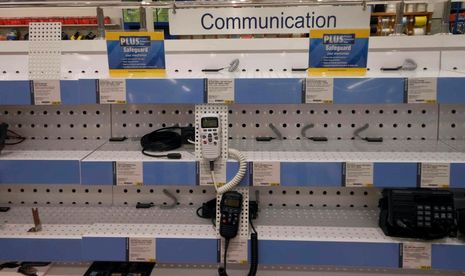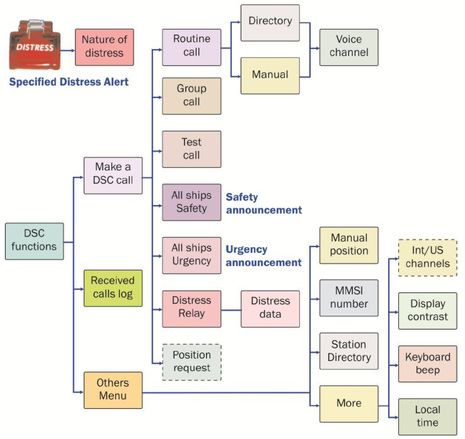VHF radio recalls, not to worry?

A Panbo reader sent this recent photo of empty VHF shelves at a West Marine in Florida along with a store manager's report that Standard Horizon and Uniden had called in their inventory for a software upgrade needed to meet an FCC regulation. Yikes? The reader wondered if this had something to do with Class D VHF mandates and worried about same model radios that had already been bought and installed. My head hurts from the research involved but I'm pretty sure that the answer is "no worries"...
What I think is going on is largely bureaucratic and has little to do with the features and performance you actually get from your radio. On March 25, 2011, it became illegal in the U.S.A. to manufacture, import, sell or install fixed VHF radios built to RTCM Standard SC-101. The ruling was U.S. specific because no other country had permitted SC-101, which made DSC VHF sets less expensive to build because the radio could just poll DSC channel 70 frequently instead of having a separate dedicated receiver to monitor it. This was a fairly big deal as SC-101 radios can miss DSC calls when they're in use, though in fact most manufacturers had already gone to full Class D (dual receiver) sets well before March, 2011.
Now we go into the weeds. What the original FCC ruling actually said was that all U.S. VHF sets must be built to the international specification ITU-R M.493-11 (which only permits Class D at minimum) but what it should have cited was the newer ITU-R M.493-13 Recommendation. So in December, 2011, the FCC issued a public notice that is sort of an apology but which also set a deadline of January 1, 2013, for full compliance with 493-13. (I challenge you to read that bit of gobbledygook without sighing.) So what is the difference between 493-11 and 493-13? Standard Horizon's Jason Kennedy told me that while he isn't an engineer he thinks that 13 tries to make DSC easier to use and is one of the reasons that many companies like his have gone to soft key radio interfaces. (The ITU lets you download a complete 493-13 PDF here; see if you can figure out what it means in terms of actual radio design, but keep headache medicine handy ;-).
Kennedy also sent me FCC certificates indicating that all current Standard Horizon radios meet the ITU 493-13 specification (it's a "recommendation" that's used as a specification). But what ruined his holidays was learning that the actual certified software had not been going into production radios as early as he thought; hence the nation-wide inventory recall "to be on the safe side." When I asked if a user could detect a difference between an updated radio and an older one, Kennedy said he very much doubted it. Standard Horizon and other manufacturers have been trying to build to the 493-13 spec for some time; the recall was just a matter of the exact FCC certified software. Apparently Uniden had a similar issue and in my research I discovered that Raymarine tried to get a 493-13 waiver for the RAY240 but the FCC denied it. I don't know why that radio couldn't be brought up to the -13 spec but apparently Ray has a new model in the works.
Another item the FCC "clarified" in that December 2011 Notice was that both ITU 493-11 and -13 require a VHF radio to have a DSC Test routine. Apparently some manufacturers had missed that nice feature in the spec (you try reading it!), but I know that Standard Horizon has had it for a while, or at least that I tried it successfully on a Matrix AIS GX2100 back in August, 2011. I appreciate the efforts of regulators to make DSC VHF easier to use, but will its use ever become common? During my research, I came across this PROPOSALS FOR A PRELIMINARY DRAFT REVISION OF
RECOMMENDATION ITU-R M.493-13 (PDF), which suggests a standard menu structure among other things. Would that make a difference? I pretty well understand all the DSC options seen in that menu below and can find them on various sets from Icom, SH, Garmin, Sailor, etc. but I rarely use them because nobody else does.
In fact, I used regular VHF a fair amount during my trip from Maine to South Carolina -- and was glad that the radios have GPS connections and are ready to output DSC Distress calls if needed -- but I never received a DSC call of any kind and didn't make any myself. Is it different in your area? Also, please speak up if you know anything more about the FCC 493-13 ruling, especially if it makes an actual difference to boaters.


 Share
Share
Hello Ben,
Re the revision of the DSC spec. The ITU committee responsible meets in Geneva in May. I am a member.
The aim of the revision will be to make DSC as easy to use as possible. Unnecessary stuff will be removed (hopefully!).
There have been 13 revisions of the spec...we want to make -14 the last for some time, so we have to get it right.
Industry, regulators, educators and users need a stable specification.
Regards
Glenn Dunstan
www.gmdss.info